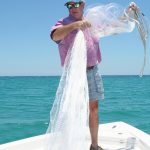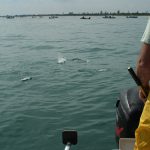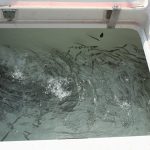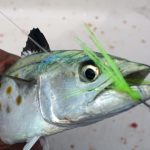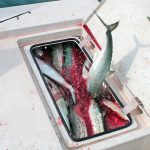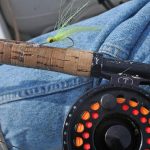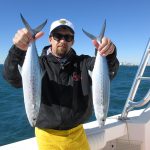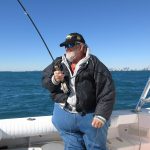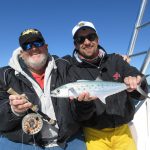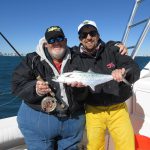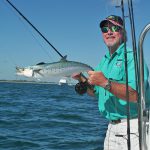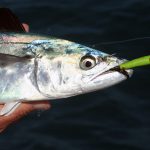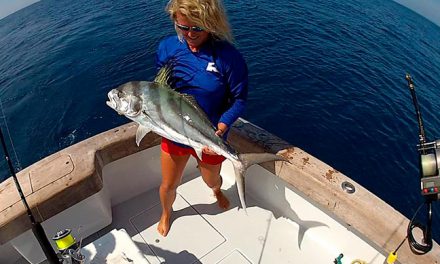By Steve Kantner
Photos Autor, Pat Ford and Dr. Martin Aróstegui
Spanish mackerel populations are on the rebound, and ribbons of these silvery predators will soon be plying the waters just south of Stuart Inlet. The locals know this area -you don’t need fancy equipment to find it as Peck Lake. What does help, however- especially when the schools head offshore is a good pair of eyes.
Just look for boat sand or diving birds and remember: Nothing motivates anglers like easy-to-catch, hard-fighting fish–and Spanish fit that description. While opinions vary on the species’ culinary merit (although practically everyone likes it fresh or smoked), their annual arrival results in an all-out assault.
How to get in on the action? Try circling the fleet. Then turn-on your depth recorder and look for a false bottom. That’s what the densely-packed schools resemble.
Or try anchoring up-wind of the flotilla and chumming with either live or dead glass minnows. Although Stuart lies at the epicenter of commercial country, a bevy of light tackle anglers, including fly fishers, now taps the resource.
I recall angler/photographer Pat Ford and I fishing Peck Lake under the capable tutelage of Capt. Steve Anderson of Port St. Lucie. There we stood, fly rods in hand, in the midst of the madness. That time we were anchored.
We were surrounded by boats, but the commotion had little effect on our fishing. Anderson had netted a live well full of glass minnows, so any reluctance on the part of the fish was fleeting. The highlights of our outing were that the fish averaged larger than usual (many were over four pounds), and that we caught them on surface poppers, as well as sunken flies.
There’s really nothing to fly fishing for Spanish. Any small streamer, preferably tied with a chartreuse or white synthetic wing, will elicit strikes. Coating the thread heads with five-minute epoxy also helps, as does any measure that protects the fly, as well as your fingers, while unhooking fish.
Don’t forget to add a short light-wire leader (we like the new knot-able stuff). While most fly fishermen rely on sinking lines for Spanish, we learned that that it isn’t necessary. The newer approach stems from an age-old problem: too much catching eventually gets boring.
No one admits this more readily than I do, nor does anyone lose interest faster. When the action slowed down to a repetitious ritual of casting and catching, Pat and I wanted a change. It was only after we were nearly run over by a pleasure boat that the fun returned.
That put down the fish temporarily, which gave Anderson time to think. While we waited for the macks to re-surface, he reached for a box of saltwater poppers.
“Try these. You tied them.”
It had been years since I’d seen them. Anderson and I had once used these babies for giant ladyfish in the Intracoastal. While I’d landed thousands of mackerel on streamers, I’d never caught a single one on a popper.
I reached for one tied on a 2/0 long-shank and attached it to my tippet. After casting, I only had to strip it once or twice before the surface erupted.
The rod lurched forward and I heard the reel scream, and for the slightest moment, I wondered if the fish would ever stop running. I lost the firstone and several others in quick succession. But, eventually, my luck turned in my favor.
After a spirited fight, “a nice one” lay in the cooler. The verdict? a five-pound Spanish caught on a popper is a thing of beauty.
The insanity continued to escalate, as Anderson tossed in more chum. Spanish were now everywhere, competing in a race with the gulls.
It wasn’t exactly a hit per cast, like with a sunken streamer. But that’s what made it interesting especially to Pat and me, who’d already caught all the fish we wanted. We felt then (and still do now) that the best part of fishing poppers is not just seeing the strike, but figuring how to provoke it. In most cases, it’s a simple pop-and-pause retrieve that we’d be likely to use for redfish. Spanish mackerel provide exciting fishing, and poppers make it just that more interesting. At the same time, these fish aren’t always interested—making finding out half the fun of it. The only effective way is to try it. Need I say more?
To see Pat Ford’s photos, go to www.patfordphoto.com.


